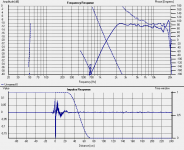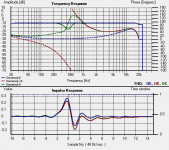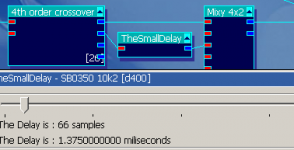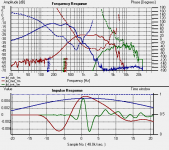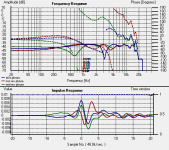Tried some VST plugins yesterday. Kinda boring with the ones that can easily match each other. Some of the weirder ones I just omitted all together but here are some that I have used which are exactly the same. I actually sat there on a couple projects and swapped out one for the other thinking one was better lol. They might be the same algorithms.
Low Q -6dB @ 7kHz FR PR THD test
Test tone is a log sweep from 1Hz-96kHz @ 192kHz 32-bit Float
Blue = Sonnox (Gentle Mastering) Q=6
Green = Izotopes Mastering Q=0.4
Yellow = Sony Track EQ Q=3.8 (Gain on the GUI is not accurate so it is set to -5.4 instead of -6)
Blue = URS N Mix Q=Q1.8
Green = Waves REQ Q=.28
Yellow = Sony Track (Same as first example)
Blue = Waves Paragraphic
Green = Ultrafunk fx
Yellow = Firium Phase Linear (Yeek! Phase linear but what is it limited to 16-bit THD?)
Low Q -6dB @ 7kHz FR PR THD test
Test tone is a log sweep from 1Hz-96kHz @ 192kHz 32-bit Float
Blue = Sonnox (Gentle Mastering) Q=6
Green = Izotopes Mastering Q=0.4
Yellow = Sony Track EQ Q=3.8 (Gain on the GUI is not accurate so it is set to -5.4 instead of -6)
An externally hosted image should be here but it was not working when we last tested it.
Blue = URS N Mix Q=Q1.8
Green = Waves REQ Q=.28
Yellow = Sony Track (Same as first example)
An externally hosted image should be here but it was not working when we last tested it.
Blue = Waves Paragraphic
Green = Ultrafunk fx
Yellow = Firium Phase Linear (Yeek! Phase linear but what is it limited to 16-bit THD?)
An externally hosted image should be here but it was not working when we last tested it.
Last edited:
Phase not bad at all... but THD?
THANKS!
This seems like a really good equalizer, that you have got there!
The phase is only affected when you affect the gain a lot.
I don't get why the THD increases that much. You can perhaps verify THD by other measuring program. (Just pick out a single frequency)
But If THD is as HOLMImpulse shows, then the distortion is a serious problem.
Ask asked me, at the recent DIYAudio event in Denmark,
THANKS!
This seems like a really good equalizer, that you have got there!
The phase is only affected when you affect the gain a lot.
I don't get why the THD increases that much. You can perhaps verify THD by other measuring program. (Just pick out a single frequency)
But If THD is as HOLMImpulse shows, then the distortion is a serious problem.
I just installed HOLMImpulse, compared to SW it is far away better and more user friendly. I use a diy microphone with a WM61A capsule.
I measured a Cyburgs Needle with a FRS8 driver at a distance of 0.5m. I added the calibration file for the WM61 but the response is very weird. There is a steep roll off starting at 5Khz. Would you advice what causes this problem, the program says my setup is fine. Card is uncalibrated ( line out --> line in ).
An externally hosted image should be here but it was not working when we last tested it.
I usually do not like to quote...Would somebody help me figure this problem out? It is interesting when I run a measurement with no mic connected, I get the same response. Adding the mic makes no change. I use a diy WM61A mic, I also tried with a vocal mic ( 80Hz-15Khz ) and a Behringer XM602 mixer - has dual mic inputs with mic preamps. No difference whether there`s a mic connected or not. I run sndrec32.exe and the recorder shows my mics are working just fine...
Hej Jonas,
"Have you tried different Holmimpulse input devices?" - if you mean by swapping the inputs to mic, line in and etc. - yes.
The record meter works fine, it reacts to any sound applied on the mic. The windows record device works as well.
I have not reinstalled it yet, but sounds like a weird issue.
En mikrofon har en WM61A och "calibration file". Det arbetar fintt. Hälsingar från Bulgarien,
Mario
"Have you tried different Holmimpulse input devices?" - if you mean by swapping the inputs to mic, line in and etc. - yes.
The record meter works fine, it reacts to any sound applied on the mic. The windows record device works as well.
I have not reinstalled it yet, but sounds like a weird issue.
En mikrofon har en WM61A och "calibration file". Det arbetar fintt. Hälsingar från Bulgarien,
Mario
Last edited:
Record Meter for troubleshooting
If you have the microphone on then try the "Record Meter" Alt+F1 and clap your hands in front of the mic, then you should see something.
Hej Jonas,
"Have you tried different Holmimpulse input devices?" - if you mean by swapping the inputs to mic, line in and etc. - yes.
The record meter works fine, it reacts to any sound applied on the mic. The windows record device works as well.
I have not reinstalled it yet, but sounds like a weird issue.
En mikrofon har en WM61A och "calibration file". Det arbetar fintt. Hälsingar från Bulgarien,
Mario
If you have the microphone on then try the "Record Meter" Alt+F1 and clap your hands in front of the mic, then you should see something.
Ask, I'm just getting more and more impressed with your software as I'm getting in to using it, it's just unbelievable how cool this is!
So a big thanks!
Anyway, just discovered something weird.
For measuring a tweeter, I applied a 1300Hz high-pass to the measurement signal. To my surprise I could not measure anything over 10 k! it just rolled off super steep!
I then went back to full frequency sweep using a passive filter on the tweeter, and then it went all the way up to 20k.
did I do something wrong?
And what does this "tap" setting do?
So a big thanks!
Anyway, just discovered something weird.
For measuring a tweeter, I applied a 1300Hz high-pass to the measurement signal. To my surprise I could not measure anything over 10 k! it just rolled off super steep!
I then went back to full frequency sweep using a passive filter on the tweeter, and then it went all the way up to 20k.
did I do something wrong?
And what does this "tap" setting do?
Yes, superb software, but I've said that before.
I did find a problem that was annoying. I took some data on one driver, then I took some data with another driver, but it clipped, so I lowered the output level in HolmImpulse. I saved all the impulse files and the "zip" file for both drivers. I found that the levels on the drivers were not correct (they should have been) and I forgot what the level difference was. I could not find anywhere that I could find what the output level was set at. Apparently the program does not keep track of that.
The program should keep track of the signal level and further, factor that in to the data. In other words, when I change the output level, the measured level on the graph should not change. Basically once the levels are set in the sound card all level adjustments are done within the software and if the software keeps track of its level settings then everything stays calibrated and my mistake would not have been a mistake at all because the program would have accounted for it.
I had to retake all of the data to get the levels right. Thats 26 seperate data sets!
I did find a problem that was annoying. I took some data on one driver, then I took some data with another driver, but it clipped, so I lowered the output level in HolmImpulse. I saved all the impulse files and the "zip" file for both drivers. I found that the levels on the drivers were not correct (they should have been) and I forgot what the level difference was. I could not find anywhere that I could find what the output level was set at. Apparently the program does not keep track of that.
The program should keep track of the signal level and further, factor that in to the data. In other words, when I change the output level, the measured level on the graph should not change. Basically once the levels are set in the sound card all level adjustments are done within the software and if the software keeps track of its level settings then everything stays calibrated and my mistake would not have been a mistake at all because the program would have accounted for it.
I had to retake all of the data to get the levels right. Thats 26 seperate data sets!
Member
Joined 2009
hi,
i'm trying to time align the drivers of an active 3-way system. i have kx-project which lets me DELAY the audio stream of individual drivers at the resolution of the sampling rate (48khz).
- i have a microphone at 1m on the height of the tweeter.
- i lock the time zero on the tweeter
- i measure each driver's response with the crossovers in place
- i count the number of samples until the tops in the IR match and i delay the appropriate amount in the dsp.
- i measure again to verify that the tops match.
the result is nasty dips in the FR close to the crossovers. what am i doing wrong?
- am i supposed to align the tops of the first positive peaks?
- am i supposed to align the first peak (negative)?
- should i be doing measurements with the crossovers?
- is there something tricky about microphone placement?
i'm trying to time align the drivers of an active 3-way system. i have kx-project which lets me DELAY the audio stream of individual drivers at the resolution of the sampling rate (48khz).
- i have a microphone at 1m on the height of the tweeter.
- i lock the time zero on the tweeter
- i measure each driver's response with the crossovers in place
- i count the number of samples until the tops in the IR match and i delay the appropriate amount in the dsp.
- i measure again to verify that the tops match.
the result is nasty dips in the FR close to the crossovers. what am i doing wrong?
- am i supposed to align the tops of the first positive peaks?
- am i supposed to align the first peak (negative)?
- should i be doing measurements with the crossovers?
- is there something tricky about microphone placement?
On my 3 way system I lock to the midrange. For some reason I have a hard time getting consistent delays from the tweeter once it has been crossed. I use the 1st positive peak as reference.
I definitely see different delays with the crossovers in place. That makes sense, as the crossover will shift phase.
Are the nasty dips just one dip at each point, or multiples? Have you tried reversing the polarity of any driver to see what it does to the dips?
Saving the impulse response of the whole system and looking at it as a sonogram is one of the best ways to see if the drivers are aligned. You can do sonograms in ARTA and some other visualization softwares.
As for mic placement - ideally you'd want it right were your head is when you listen. But closer than that will often work. Try to think of how the sound waves will integrate on the way to your ears and place the mic accordingly.
I definitely see different delays with the crossovers in place. That makes sense, as the crossover will shift phase.
Are the nasty dips just one dip at each point, or multiples? Have you tried reversing the polarity of any driver to see what it does to the dips?
Saving the impulse response of the whole system and looking at it as a sonogram is one of the best ways to see if the drivers are aligned. You can do sonograms in ARTA and some other visualization softwares.
As for mic placement - ideally you'd want it right were your head is when you listen. But closer than that will often work. Try to think of how the sound waves will integrate on the way to your ears and place the mic accordingly.
Member
Joined 2009
thanks, panomaniac!
it sounds like i was doing the right thing from what you are saying. i was getting some results that didn't make sense to me so i got frustrated and didn't save any plots. i will try again soon and definitely post some results.
i was able to successfully align the 3 drivers on the first positive peak. then i moved the microphone to another location and took measurements again. the 3 impulse responses were still aligned on the first positive peak. but there are some observations that made me doubt that this was actually working.
1. my system frequency response experienced a dip a little after the mid-tweeter crossover. i tried flipping the phase on either the mid or the tweeter but that shifted the dip and did not eliminate it.
2. i measured the distance from the center of the voice coil of each driver to the baffle plane. tweeter - .5cm, mid -3cm, woofer - 7.5cm. at 48khz sampling rate a cm = 3.3samples (give or take). my measurements showed that i needed to delay the mid driver about 10samples which sounds correct but for the woofer i got 55samples which is twice as what i estimated.
3. i was under the impression that correctly implemented digital filters don't affect the phase. i use kx-project which employs digital crossovers and filters in the sound card dsp. they have no specs or documentation on their components but the author claims that the crossover doesn't shift the phase. now i tend to think that all crossovers affect the phase in some way so i will have to make some calibration measurements on the crossovers to understand better how they work.
it sounds like i was doing the right thing from what you are saying. i was getting some results that didn't make sense to me so i got frustrated and didn't save any plots. i will try again soon and definitely post some results.
i was able to successfully align the 3 drivers on the first positive peak. then i moved the microphone to another location and took measurements again. the 3 impulse responses were still aligned on the first positive peak. but there are some observations that made me doubt that this was actually working.
1. my system frequency response experienced a dip a little after the mid-tweeter crossover. i tried flipping the phase on either the mid or the tweeter but that shifted the dip and did not eliminate it.
2. i measured the distance from the center of the voice coil of each driver to the baffle plane. tweeter - .5cm, mid -3cm, woofer - 7.5cm. at 48khz sampling rate a cm = 3.3samples (give or take). my measurements showed that i needed to delay the mid driver about 10samples which sounds correct but for the woofer i got 55samples which is twice as what i estimated.
3. i was under the impression that correctly implemented digital filters don't affect the phase. i use kx-project which employs digital crossovers and filters in the sound card dsp. they have no specs or documentation on their components but the author claims that the crossover doesn't shift the phase. now i tend to think that all crossovers affect the phase in some way so i will have to make some calibration measurements on the crossovers to understand better how they work.
Just discovered HOLMImpulse today, it's the best piece of measurement software that I have tried 
The following measurement is BMS 4552Nd on 18Sound XT1086 horn at 1 meter on-axis, with constant directivity eq, LR24 crossover at 1400Hz and group delay correction for approaching actual acoustic LR24 response (all done with DCX2496).
The following measurement is BMS 4552Nd on 18Sound XT1086 horn at 1 meter on-axis, with constant directivity eq, LR24 crossover at 1400Hz and group delay correction for approaching actual acoustic LR24 response (all done with DCX2496).
Attachments
Last edited:
A few days ago I decided to uninstall it as it didnt work with my pc/setup. I opened the rec meter and it was as always - working perfectly and reacting to every sound. I decided to do a last attempt an it worked just fine, got a nice freq response, phase and etc. Since it didn`t work I did not move neither change anything. I didn`t switch off any of the devices.Sometimes I do not understand computers...
Software is really great, thank you!
Software is really great, thank you!
Member
Joined 2009
ok, i was partially able to answer my question but i raised other ones. i ran a cable from the output to the input of the sound card and did some measurements on my dsp setup. the DELAY i'm using is causing a drop in the frequency response around the crossover.
blue = straight loopback signal. pretty standard for audigy 2 zs i suppose.
red = a 4th order LR crossover at 500hz with kx-project
green = the previous crossover with 66samples delay on the high end
the delay module introduces an obvious dip in the frequency response. i thought if i graph each hi-low segment with-and-without the delay i will see inconsistencies in the FR, phase or the IR but it doesn't seem to affect them. it only shows up when they are summed up together.
can somebody explain what's going on and how can i get around it?
blue = straight loopback signal. pretty standard for audigy 2 zs i suppose.
red = a 4th order LR crossover at 500hz with kx-project
green = the previous crossover with 66samples delay on the high end
the delay module introduces an obvious dip in the frequency response. i thought if i graph each hi-low segment with-and-without the delay i will see inconsistencies in the FR, phase or the IR but it doesn't seem to affect them. it only shows up when they are summed up together.
can somebody explain what's going on and how can i get around it?
Attachments
Member
Joined 2009
and here are some measurements on the actual drivers. the first picture shows them time aligned on the first positive peak. the sub and mid are accentuated for clarity.
in the second pic blue is the whole system with the dip.
the red is with the phase on the tweeter flipped and the green is with the phase on the midwoofer flipped.
can somebody shed some light on what's going on?
in the second pic blue is the whole system with the dip.
the red is with the phase on the tweeter flipped and the green is with the phase on the midwoofer flipped.
can somebody shed some light on what's going on?
Attachments
- Home
- Design & Build
- Software Tools
- HOLMImpulse: Measurements in practice
